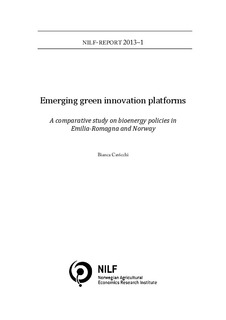| dc.contributor.author | Cavicchi, Biancha | |
| dc.coverage.spatial | Norway, Italy, Emilia-Romagna | nb_NO |
| dc.date.accessioned | 2017-06-09T07:32:13Z | |
| dc.date.available | 2017-06-09T07:32:13Z | |
| dc.date.created | 2017-06-02T13:00:14Z | |
| dc.date.issued | 2013 | |
| dc.identifier.isbn | 978-82-7077-854-6 | |
| dc.identifier.issn | 0805-7028 | |
| dc.identifier.uri | http://hdl.handle.net/11250/2445504 | |
| dc.description.abstract | Bioenergy and rural development are increasingly under political focus. Bioenergy development is considered as a tool to deal with the climate change and rural areas crisis. The European Directive 2009/28/CE has set the goals for bioenergy production, and the Regulation 1698/2005 on rural development links the improving of conditions in rural areas to renewable energy production. Rural areas are the source of raw materials and the place to set bioenergy installations, while the new activity could provide rural citizens with new jobs and green energy. This policy context is understood in the view of other three main European policies, namely the regional, climate change and green growth and the innovation policies. Rural development is deeply tied to the former that points at rural regions as the ones to be stronger supported. The innovation policy engages regions in an effort to strengthen innovation policies and learning by interacting throughout the European Area. The focus of the thesis is on Italy and further on Emilia-Romagna, as one of the most developed Italian regions. Emilia-Romagna is compared with Norway, a non- European Union country that has a different administrative and policy structure, but one that is nevertheless influenced by EU policies through the ETA. Within the two main case studies, I considered individual case studies to find out the practices and the links between the two core policy areas. The results have been framed and assessed through the regional innovation systems theory, in order to explain how the bioenergy system and rural development are fostered in Emilia-Romagna and Norway. The main findings show two different policy frameworks and how they affect the development of the bioenergy and rural areas. Emilia-Romagna has a confused situation and a difficult confrontation between rural citizens, bioenergy investors and local governments, but the sector is still more developed than in Norway. Moreover the feed in tariff is fostering single random investments. By contrast, Norwegian policy framework is more easily accessible, the investments are more locally-based and there is no national feed-in-tariff. Thus, the actors cooperate more in order to invest in a bioenergy activity, while rural communities seem to experience positive local return in terms of new jobs and energy prices. | nb_NO |
| dc.language.iso | eng | nb_NO |
| dc.publisher | Norsk institutt for landbruksøkonomisk forskning | nb_NO |
| dc.relation.ispartof | NILF-Report | |
| dc.relation.ispartofseries | NILF-rapport;2013-1 | |
| dc.subject | Bygdeutvikling | nb_NO |
| dc.subject | Sustainable rural development | nb_NO |
| dc.subject | Bioenergi | nb_NO |
| dc.subject | Bioenergy | nb_NO |
| dc.subject | Innovasjon | nb_NO |
| dc.subject | Innovation | nb_NO |
| dc.title | Emerging green innovation platforms. A comparative study on bioenergy policies in Emilia-Romagna and Norway | nb_NO |
| dc.type | Research report | nb_NO |
| dc.subject.nsi | VDP::Statsvitenskap og organisasjonsteori: 240 | nb_NO |
| dc.subject.nsi | VDP::Political science and organisational theory: 240 | nb_NO |
| dc.source.pagenumber | 65 | nb_NO |
| dc.source.issue | 01 | nb_NO |
| dc.identifier.cristin | 1473752 | |
| dc.relation.project | Norsk institutt for landbruksøkonomisk forskning: M140 | nb_NO |
| cristin.ispublished | true | |
| cristin.fulltext | original | |
